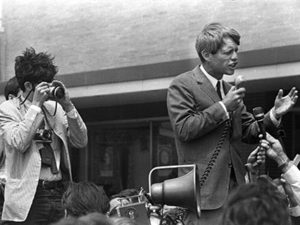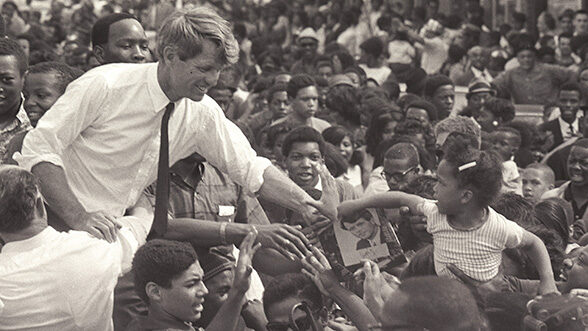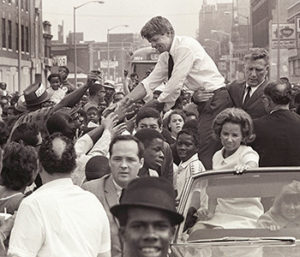In May 1968, Michigan Daily photojournalists Andy Sacks and Jay Cassidy joined the open-air motorcade of Robert F. Kennedy in Detroit. Sacks’ picture appeared 50 years later — w/Bill Eppridge’s photo credit — on the cover of Chris Matthews’ “Bobby Kennedy: Raging Spirit.” Listen in, as Sacks and Cassidy relive that day in ’68. Learn more about Sacks’ work at www.saxpix.com. In addition, Cassidy recently was featured in a Michigan Alumnus video. View a Michigan Today slideshow of his images. Hear more “Listen In, Michigan” podcasts and subscribe at iTunes, Tunein, and Stitcher.
Judging a book by the cover

Andy Sacks photographs Robert F. Kennedy, Detroit, May 1968. (Image credit: Jay Cassidy Collection, U-M’s Bentley Historical Library.)
As a 20-year-old Michigan Daily photographer, Andy Sacks, AD ’69, so convincingly pitched LIFE magazine to let him cover a campus protest that the editor flew in her own guy, Bob Gomel, from New York. But she encouraged Sacks to shoot the action anyway and submit his raw film for consideration.
In the 1960s, LIFE was the pinnacle, the Holy Grail, the Mt. Olympus of editorial photography. And after a few years covering student unrest in turbulent Ann Arbor, Sacks was confident and competent when it came to shooting chaos on the campus and elsewhere. When the Dec. 9, 1966, issue of LIFE landed, it was Sacks’ picture of the campus rally the editor published. It ran with the cover story, “The draft: Who beats it and how.”
Call it the arrogance of youth, but Sacks took the professional coup in stride. So a few years later, when he worked alongside another LIFE photographer whose work he admired, Sacks was more intrigued than intimidated. It was May 1968, and Robert F. Kennedy had just entered a number of presidential primary races. Campaign stops brought the candidate to Detroit and Indianapolis, which is where Sacks met LIFE’s Bill Eppridge in an open-air motorcade. Eppridge’s harrowing 1965 photo essay “Needle Park,” had elevated photojournalism to an art form, and to Sacks, the 29-year-old Eppridge was a seasoned veteran. He took the opportunity to watch and learn.
“Bill was deliberate, self-assured, and somewhat graceful,” Sacks says. “He carried three cameras – maybe two around his neck, one on his shoulder. The long telephoto lens was not pointed out with the body of the camera against his hip. It actually was turned the other way: nestled into his hip to protect the equipment and move through the crowd more efficiently. Those are things you don’t learn in a book.”
Fast forward
When Sacks first saw the cover of Chris Matthews’ biography Bobby Kennedy: A Raging Spirit (Simon & Schuster, 2017), he thought fondly of Eppridge, whose name appeared in the cover-photo credit line on the book jacket.
Eppridge, who had a relationship with the Kennedys, died in 2013. The RFK cover certainly captured a magnificent moment in time: An ebullient crowd jams the street and swarms the candidate’s convertible. He is smiling at a little girl, held aloft in a large adult hand. An aide’s arm is wrapped around Kennedy’s waist, anchoring him in the convertible. The crowd is mostly young, mostly African American, and mostly male. Hands dominate the foreground — outstretched, reaching.
But the joy so palpable in the photograph would be fleeting. Kennedy was assassinated in Los Angeles three weeks later on June 5, 1968.
Sacks recognized the setting in Detroit. Eppridge likely was riding shoulder-to-shoulder with him in the convertible “camera car” because the image looked much like his own from that day. Then a friend called to congratulate Sacks on landing the book cover, and he took a closer look at 15 frames he’d previously submitted to Getty Images for licensing to worldwide media.
There it was. That picture on the cover of Matthews’ book belonged to Sacks. It didn’t make the photo editor’s cut at The Daily back in 1968, but it worked for Simon & Schuster in 2017. And now some 50 years had passed, and Sacks had outperformed LIFE magazine again. This time, however, the irony came with a sting.
Re-shoot
Through a Getty attorney, Sacks says he notified Simon & Schuster of the mistake in November 2017. Matthews’ book was about three weeks into sales at that time. The New York Times bestseller is now in its fourth hardcover printing, and the publisher has yet to right the wrong.
Simon & Schuster acknowledges the error, says Sacks’ attorney, fellow Michigan Daily alumnus Stephen Selbst, BA ’76/JD ’80, a partner at New York’s Herrick, Feinstein, LLP. But the publisher, he says, rejects any liability for what it deems an innocent mistake.
“For technical reasons related to the copyright act, they hold the position they are not responsible for the problem,” Selbst says.
Simon & Schuster contends the graphic artist who produced the cover had dummied in a Bill Eppridge shot for an early iteration of the design but used a Sacks photo for the final version, says Selbst. So the dust jacket went to press with Sacks’ photo on the cover and Eppridge’s name in the credit line.
They never knew one another, but Sacks imagines the late photographer would be as aggravated by the mistake as he is, “just on a guy-to-guy basis,” he says. “But, if someone else’s name is on your photo, it’s a pretty great compliment if it says Bill Eppridge.”
Turn the page
A spokeswoman for Simon & Schuster confirmed in an email June 28 that Sacks’ credit will appear in future softcover editions.
But that doesn’t explain the publisher’s tardiness in righting the wrong against Sacks. Selbst says Simon & Schuster manufactured the fourth hardcover printing of Matthews’ book — notwithstanding the fact that the publisher was on notice regarding the error. Notably, the editorial staff did make revisions – to other photo credits in the book – before going back on press with that fourth printing, Selbst says. And still, they missed the cover credit.
“They demonstrated by their actions that they know how to correct their errors,” he says. “But they didn’t correct Andy’s.”
Selbst is now exchanging letters regarding the finer points of copyright law with a pre-eminent legal expert, bankrolled by an international publishing house. Michigan Today emailed and called the publisher’s lawyer at New York’s Davis Wright Tremaine, LLP, but has yet to hear back.
“It’s a classic David & Goliath case,” Selbst says. “There is no question that Andy has been harmed. I’ve known him for a long time and have had the occasion to see lots and lots of his work. This is probably the most dramatic photo he’s ever taken.
“Today, you could never get that close to a candidate,” Selbst continues. “You would never be able to capture that immediacy and that power. That picture is so powerful.”
So much for posterity
Getty Images licensed the photo to Simon & Schuster for $500. (The image is credited correctly in Getty’s archives.) The license entitles the publisher to use the picture (worldwide) on 1 million books, Sacks says.
The challenge for Selbst and Sacks is to quantify economic losses the photographer suffered as a result of Simon & Schuster’s mistake. It’s the plaintiff’s burden to prove what, if any, portion of the profits earned by the publisher are attributable to the cover photograph, Selbst says.
That is difficult to demonstrate in a court of law, he says. The attorney hopes to make progress in the court of common decency, though, as he seeks an out-of-court settlement from the publisher.
For Sacks, the pain of this sucker punch to his artistic legacy is not likely to dissipate any time soon.
“My wife, Ann, found that even Google believes Bill Eppridge is the creator of that photo on the hardcover version of the Matthews biography,” he says. “What will Google make of the softcover volume crediting a different man for the same photograph? Don’t believe everything you see on the Internet.”
Sacks, who currently lives in Chelsea, Mich., recently produced two documentaries based in metropolitan Detroit: Let’s Have Some Church Detroit Style won an Emmy award in 2016, and Grooming a Generation, about barbershop reading programs, was released in 2017. Both films appeared on PBS.








David Haron - 1966 BA, 1969 JD
Great article. Why doesn’t Chris Matthews, speaking to thousands virtually every night say something, have Andy on his show, anything?
Reply
Bob Shilland - ‘70 LSA
Good point, David!
Reply
Charlotte Wolter - 1967
Andy Sacks was one of the greatest photographers who ever worked for the Michigan Daily. I worked with him both before and after my time as a Daily editor. His work always was striking and bold, like the book cover. Simon & Schuster needs to honor him as a fine journalist and artist.
Reply
Carl Stein - 1982
“Campaign stops brought the candidate to Detroit and Indianapolis, which is where Sacks met LIFE’s Bill Eppridge in an open-air motorcade…. ‘Bill was deliberate, self-assured, and somewhat graceful,’ Sacks says.”
10 paragraphs later: “They never knew one another.”
Huh? Sacks met Eppridge in Indianapolis but they never knew one another? Meeting in Indianapolis doesn’t count in real life?
Reply
Deborah Holdship
I get your point. My wording is imprecise. Sacks and Eppridge worked the same event in a press scrum, but they were never friends. DH
Reply
Barbara Alexander
I am an LSA graduate of 1968 (Barbara Reid). That spring I joined a group of U of M students who were recruited to travel by bus to Indiana to do canvassing of voters in the neighborhoods of South Bend. We were housed wit local volunteers. After we successfully targeted low income and African American neighborhoods (imagine a bunch of white kids doing this today!!) , we kept our notes on 3X5 cards that were then turned into the campaign office for targeted get out the vote calls. That year was one of the first efforts at such targeted campaigns and contacts. Some of us were asked to continue on the campaign to Oregon and California. I worked in the Portland, OR office, organized “teas” for some of the Kennedy sisters, worked on rallies and organized local students for canvassing. I then went to California where I worked in San Francisco and the famous China Town rally and motorcade. Then of course it all ended. I was invited and attended his funeral in New York (not the train ride). I had some interesting experiences after that, including helping to organize the national Earth Day events in 1970—working out of the DC office that coordinated this national “day.”
See, Rome, Adam, The Genius of Earth Day (2013).
Just so you know that other U of M students were also very involved in the RFK campaign and what an impact it had on me and my life in public service.
Barbara
Reply
Bill Scanlon - JD, 1977
I was literally about to buy Matthews’ 2017 book about RFK when I read this post. I was about to do this to do something – anything, no matter how foolish and futile – to soften the painful remembrance of losing RFK, who remains my political hero, 50 years ago. I was about to do it even though Matthews in his writing and reporting has done little but exploit RFK’s story without having had anything more significant to do with it than I, a poor bloke from the Midwest, had.
Now I’m not buying it.
What is reported in this post is an horrific, completely unjust and otherwise unacceptable rip-off of Andy Sacks.
Beyond Simon and Schuster’s obvious culpability, I am disgusted that Matthews has done nothing publicly to soften the wrong. So I’m also no longer bothering with his pontificating on MSNBC
Reply